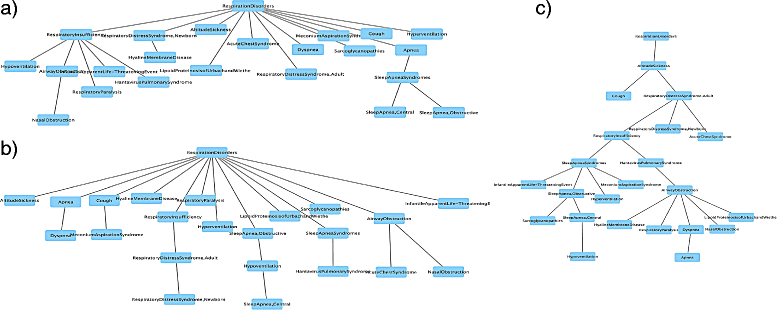Towards a more molecular taxonomy of disease
- PMID: 28750648
- PMCID: PMC5530939
- DOI: 10.1186/s13326-017-0134-0
Towards a more molecular taxonomy of disease
Abstract
Background: Disease taxonomies have been designed for many applications, but they tend not to fully incorporate the growing amount of molecular-level knowledge of disease processes, inhibiting research efforts. Understanding the degree to which we can infer disease relationships from molecular data alone may yield insights into how to ultimately construct more modern taxonomies that integrate both physiological and molecular information.
Results: We introduce a new technique we call Parent Promotion to infer hierarchical relationships between disease terms using disease-gene data. We compare this technique with both an established ontology inference method (CliXO) and a minimum weight spanning tree approach. Because there is no gold standard molecular disease taxonomy available, we compare our inferred hierarchies to both the Medical Subject Headings (MeSH) category C forest of diseases and to subnetworks of the Disease Ontology (DO). This comparison provides insights about the inference algorithms, choices of evaluation metrics, and the existing molecular content of various subnetworks of MeSH and the DO. Our results suggest that the Parent Promotion method performs well in most cases. Performance across MeSH trees is also correlated between inference methods. Specifically, inferred relationships are more consistent with those in smaller MeSH disease trees than larger ones, but there are some notable exceptions that may correlate with higher molecular content in MeSH.
Conclusions: Our experiments provide insights about learning relationships between diseases from disease genes alone. Future work should explore the prospect of disease term discovery from molecular data and how best to integrate molecular data with anatomical and clinical knowledge. This study nonetheless suggests that disease gene information has the potential to form an important part of the foundation for future representations of the disease landscape.
Keywords: Disease Ontology; Disease Ontology inference; Disease gene association; Disease tree inference; Hierarchical clustering; Medical Subject Headings tree; Pairwise disease similarity; Parent Promotion.
Conflict of interest statement
Ethics approval and consent to participate
Not applicable.
Consent for publication
All authors read and approved the final version of the manuscript.
Competing interests
The authors declare that they have no competing interests.
Publisher’s Note
Springer Nature remains neutral with regard to jurisdictional claims in published maps and institutional affiliations.
Figures




References
-
- Denny JC, Ritchie MD, Basford MA, Pulley JM, Bastarache L, Brown-Gentry K, Wang D, Masys DR, Roden DM, Crawford DC. PheWAS: demonstrating the feasibility of a phenome-wide scan to discover gene-disease associations. Bioinformatics. 2010;26(9):1205–10. doi: 10.1093/bioinformatics/btq126. - DOI - PMC - PubMed
-
- Desmond-Hellmann S, Sawyers CL, et al. Toward precision medicine: Building a knowledge network for biomedical research and a new taxonomy of disease. Technical report, National Research Council. 2011. - PubMed
MeSH terms
Grants and funding
LinkOut - more resources
Full Text Sources
Other Literature Sources
Miscellaneous

